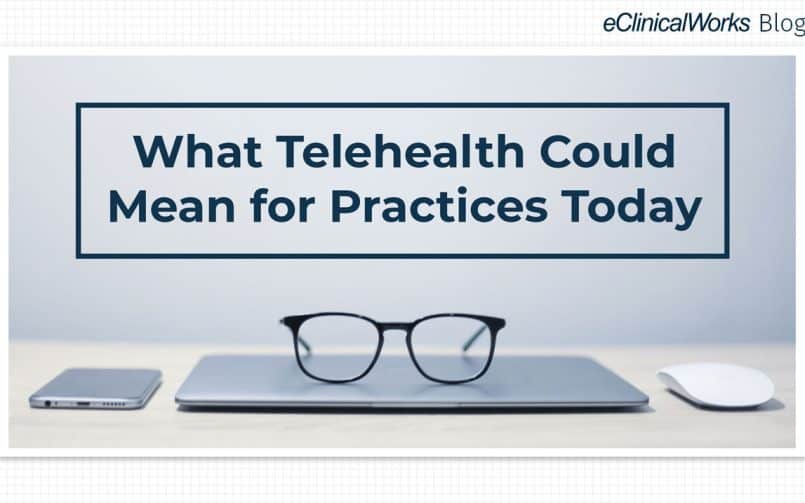Flattening the Curve With Telehealth
- 2 April 2020
- Blog
eClinicalWorks

A tale of a pandemic’s two curves
Medical pandemics come with two curves. There is a learning curve that challenges doctors, researchers, and governments to find the most effective responses. Meanwhile, there is an infection curve that must be moderated or flattened in order to get ahead of the crisis.
Slowing the spread of illness buys critical time for doctors and nurses to manage existing caseloads, while hospital systems and public health authorities gather additional tools and resources to contain, manage, and ultimately put an end to a pandemic.
For now, the new normal is necessary
No one is happy about dramatic changes to daily routines, but for now such changes appear to be the most effective means of curbing infections and saving lives.
From the suspension of sporting events and public gatherings to business closures and social distancing, Americans are adjusting to a new normal that seems likely to last another month or more.
When it comes to medical care, telehealth technologies are proving to be of great benefit for patients’ physical and mental health. History suggests those technologies are doing something more — saving lives.

Learning some lessons from history
A look at the 1918 flu pandemic that swept the world — which killed millions worldwide and 675,000 people in the U.S. — shows the difference lifestyle changes can make.
With no vaccine available — the first effective flu vaccine wasn’t until 1938 — U.S. cities took different approaches.
Philadelphia proceeded with a Liberty Loan parade, which fueled a spike in infections and deaths. St. Louis, by contrast, quickly shut schools and theaters and curtailed public gatherings, and had only one-eighth as many infections as Philadelphia.
In San Francisco, strong measures blunted the first wave of flu, but relaxed vigilance meant the city was struck harder in January 1919. Keeping measures in place, historians say, could have reduced deaths by 90%.
Coronavirus: Looking ahead
The course of the coronavirus pandemic is uncertain, but the resources available to combat it are far greater than a century ago. While research into a vaccine continues, physicians have three major advantages over 1918:
- First, hospital facilities are larger and better equipped, able to deal with effects of an outbreak, including drugs to treat secondary bacterial infections and ventilators to aid those who are most ill.
- Second, today’s highly connected society makes it easier to communicate information about non-pharmaceutical interventions, including business closures, quarantines, social distancing, and public health advisories.
- Third, physicians have electronic resources available to them that were unheard of in 1918, including the means to deliver care remotely via telehealth.
eClinicalWorks remains committed to meeting the needs of medical providers throughout this crisis and beyond. Our commitment to the innovation, tools, and service needed to meet emerging medical challenges is stronger than ever.
Related Post

- 9 January 2025
- Blog
Unveiling Trends Set to Transform Healthcare in 2025

- 15 February 2024
- Blog
AI Medical Scribes in Remote Healthcare Services

- 7 November 2023
- Blog
Embracing Technology for Startup Weight Loss and Medical Spa Clinics

- 27 September 2022
- Blog
Back to School — for Your Practice, Too!

- 21 June 2022
- Blog
Dermatology Made Easier This Summer

- 25 March 2022
- Blog
HIMSS22 Outlines Opportunities in Healthcare

- 17 February 2022
- Blog
Defense Matters: Keeping Remote Medicine Safe

- 1 February 2022
- Blog
One Key for 2022: Staying Focused on Patients

- 28 January 2022
- Blog
4 Patient Engagement Solutions to Help Patients and Practices in 2022

- 25 January 2022
- Blog
The Right Tools During Challenging Times

- 19 January 2022
- Blog
Healthcare 2022: Regulatory Trends to Look for in the Year Ahead

- 18 November 2021
- Blog
Remaining Vigilant in the Lung Cancer Fight

- 4 November 2021
- Blog
Telehealth Is Long-Established Science Fact

- 2 September 2021
- Blog
It’s Time for a Better Check-in Solution

- 12 August 2021
- Blog
Using hello2healow for Patient Outreach in Florida

- 27 May 2021
- Blog
When Neurological Care Cannot Wait

- 20 May 2021
- Blog
Solutions for Allergy Testing, Tracking, and Treatment

- 16 March 2021
- Blog
A Partner for Reinventing Your Practice

- 2 March 2021
- Blog
What it Takes to Better Know Your Patients

- 29 January 2021
- Blog
Putting the Pieces Together for Quality Healthcare

- 30 December 2020
- Blog
2020 eClinicalWorks Year in Review

- 22 December 2020
- Blog
Thirlby Clinic: Using Telehealth and CCM for Better Disease Management

- 15 December 2020
- Blog
A Challenging Year Is Ending — New Opportunities Ahead

- 10 December 2020
- Blog
How a Practice Found Success With Telehealth & Contactless Check-In

- 24 November 2020
- Blog
The Continuing Influence of Telehealth

- 19 November 2020
- Blog
Meeting the Demand for Behavioral Health Services

- 12 November 2020
- Blog
Reinventing Healthcare for a Brighter Future

- 6 November 2020
- Blog
How Little River Medical Center Thrived During the Pandemic

- 19 October 2020
- Blog
How Telehealth, CCM, and Contactless Check-In Revitalized a Practice in Need

- 15 October 2020
- Blog
Targeting Behavioral Health, Remote Care & More

- 30 September 2020
- Blog
Surviving COVID-19: Telehealth and Beyond

- 21 September 2020
- Blog
3 Important healow TeleVisits Features

- 9 September 2020
- Blog
It’s Your Practice — Dream Big!

- 1 September 2020
- Blog
Back to the Basics During the COVID-19 Era

- 28 August 2020
- Blog
How the Patient Portal Is Making a Difference for a Pediatric Practice

- 24 July 2020
- Blog
Pushing Boundaries, Reaching New Horizons

- 17 July 2020
- Blog
How to Keep Your Patients & Staff Safe During COVID-19

- 1 July 2020
- Blog
How to Digitize Your Front Office

- 29 June 2020
- Blog
The Telehealth Revolution Continues

- 24 June 2020
- Blog
How Advocare Put healow TeleVisits™ to Work

- 17 June 2020
- Blog
How Telehealth Is Connecting Patients & Providers

- 12 June 2020
- Blog
Finding a New Normal: The Patient Experience

- 10 June 2020
- Blog
Minding Mental Health During COVID-19

- 3 June 2020
- Blog
Expanding the Range of Specialty Care

- 1 June 2020
- Blog
Reinventing Your Practice

- 29 May 2020
- Blog
What Telehealth Could Mean for Practices Today

- 27 May 2020
- Blog
Resourceful Action During Extreme Times

- 21 May 2020
- Blog
Like Telehealth? There’s More!

- 19 May 2020
- Blog
The Numbers Behind TeleVisits

- 16 May 2020
- Blog
What Telehealth Can Do for Specialty Practices

- 13 May 2020
- Blog
Routine Care During Nonroutine Times

- 12 May 2020
- Blog
How Telehealth Will Make The 21st Century Ours

- 8 May 2020
- Blog
Seeing Medicine in a New Light

- 7 May 2020
- Blog
Telehealth: Healing Action at a Distance

- 5 May 2020
- Blog
3 Patient Stories of TeleVisits in Action

- 1 May 2020
- Blog
Sustaining Medical Practice During COVID-19

- 29 April 2020
- Blog
The Evolution and Importance of Telehealth

- 27 April 2020
- Blog
Deriving Greater Value from Telehealth

- 24 April 2020
- Blog
3 Practices Finding Success With Telehealth

- 22 April 2020
- Blog
How Innovation Fueled the Rise of Telehealth

- 20 April 2020
- Blog
Why You Should Activate Telehealth Today

- 17 April 2020
- Blog
3 Practices Using Telehealth to Improve Patient Care

- 15 April 2020
- Blog
Shift in the Medical Mindset

- 13 April 2020
- Blog
How Telehealth Kept a Patient Out of the ER

- 10 April 2020
- Blog
Speeding Toward a New Healthcare Paradigm

- 9 April 2020
- Blog
How Dallas Renal Group is Providing Care While Social Distancing

- 8 April 2020
- Blog
Swift Action Results in Change of Telehealth Regulations

- 7 April 2020
- Blog
How Central Ohio Primary Care Physicians is Reducing ER Visits

- 6 April 2020
- Blog
Securing Access to Care During a Pandemic

- 3 April 2020
- Blog
How Telehealth is Keeping Patients Safe at Trusted Doctors

- 1 April 2020
- Blog
How First Choice Neurology Transformed Their Practice With Telehealth

- 31 March 2020
- Blog
Telehealth and Mental Health in a Time of Crisis

- 27 March 2020
- Blog
How SG Pediatrics are Using TeleVisits to Help Patients

- 26 March 2020
- Blog
The eClinicalWorks Telehealth Advantage

- 25 March 2020
- Blog
How Televisits Have Transformed Comprehensive Sleep Center

- 24 March 2020
- Blog
Telehealth: Helping Throughout History

- 23 March 2020
- Blog
How healow TeleVisits Can Help During a Health Crisis

- 20 March 2020
- Blog
healow TeleVisits: How Fast Deployment Helps

- 11 March 2020
- Blog
Expanding Access to Care With healow TeleVisits

- 17 January 2020
- Blog
Teledentistry: Expanding Access to Dental Care

- 8 January 2020
- Blog
The State of Telehealth in 2020

- 14 August 2019
- Blog
Patient-Centered Care: How the Approach Can Improve Healthcare

- 5 June 2019
- Blog
3 Ways That Telehealth Is Improving Healthcare

- 9 January 2019
- Blog
Telehealth – Rural Health Center

- 1 November 2018
- Blog
Three Ways Telemedicine Improves Care for Providers and Patients

- 15 October 2018
- Blog
How telehealth helps to improve compliance among ADHD patients

- 7 October 2018
- Blog
Powering Through on Game Day!

- 6 October 2018
- Blog
Making Connections on Saturday

- 30 May 2018
- Blog
ADHD and Telemedicine: A Natural Fit
- 20 March 2015
- Blog
The Next Phase of Innovation in Healthcare
- 20 March 2015
- Blog








